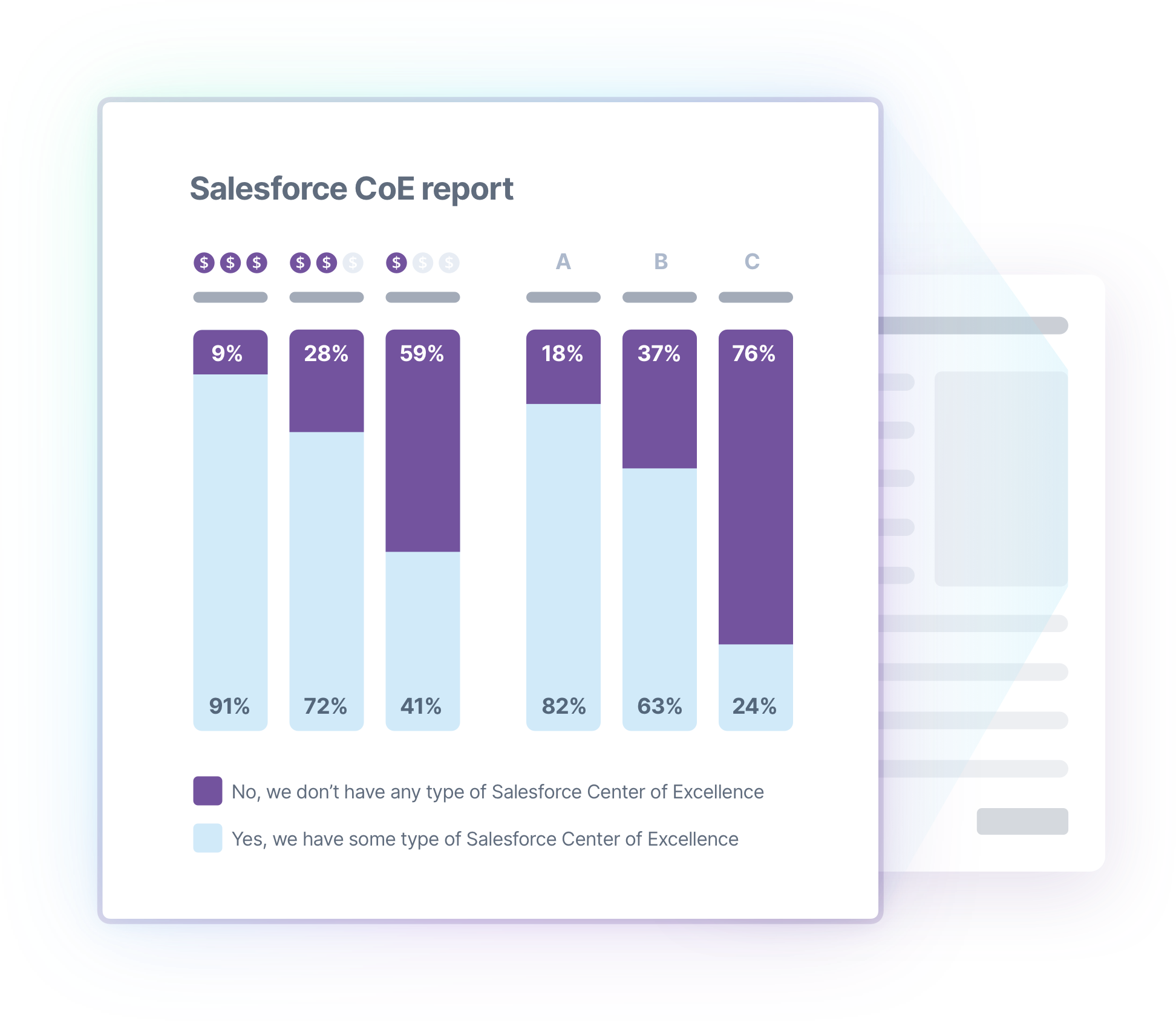Center of Excellence
Salesforce Orgs have become complex and strategic. Transformation programs need vision, direction, governance, coordination, standards, and innovation.
A Center of Excellence provides the structure that transformation programs need to deliver repeatable results. A Change Intelligence Platform provides the support that a Center of Excellence needs to be effective.

Reduces risk. Accelerates innovation.
A Center of Excellence needs the collaborative and operational support of a Change Intelligence platform to be successful. The platform provides the structure, governance, documentation, and analysis. It bridges the gap between the business and development. It engages the different stakeholders breaking silos and unlocking productivity gains. It is the platform for shared innovation to enable you to deliver changes consistently with confidence, at pace.
Reduces risk
Changes can be accelerated when the risk is understood. Change Intelligence provides visibility and analysis of technical, business and technical risk.
Standardization
Providing centralized standards and automated governance reduces admin overhead and enables control, even when moving at pace.
Centralized documentation
Change decisions can be made with confidence when all stakeholders are working from centrally managed metadata, analysis, and documentation.
Accelerates innovation
Understanding how and where you can innovate and make the greatest impact requires Change Intelligence and strong governance.
Center of Excellence structure
13 pillars of a COE
- Vision: strategic vision and direction for Salesforce for both the business and IT
- Leadership: Steering Committee and key sponsors in business and IT
- Governance: overall control of strategic direction, business cases, investment and risk management
- Change control: management of changes to all aspects of the project
- Methodology: the implementation methodology covering people, process and technology, which includes business analysis, DevOps and adoption.
- Standards: includes standards for business analysis, Org documentation, metadata naming, coding, testing, communication, change management and training
- Metadata management: control of the Salesforce metadata across the deployment pipeline
- Architecture: technical architecture of Salesforce and how it relates to the integrated systems and InfoSec
- Security: security needs to be architected in from the start
- Change management: communications, organizational change and training to get Salesforce adopted
- PMO: the Project Management Office that manages the COE activities
- Tooling: platforms/apps/ tools used to support the projectInnovation: AI is accelerating innovation inside Orgs. The innovation hub that builds out Salesforce prototypes to show the “art of the possible”.
Center of Excellence highlights
The 10K Advisors survey showed that 91% of the most successful customers they talked to had a Center of Excellence. We hear from COE Leaders and consultants how to get started, the benefits and building a business case.
Read the latest articles from the team
Stay informed with key insights, product updates, and expert how-to guides from the elements team.
Frequently asked questions
13 pillars define the different skills or capabilities that make up a Center of Excellence. Not every one of them needs to be in place on day one. Based on the size and complexity of the Org more and more of the pillars need to be in place. We see Orgs that are thinking of implementing AI need more pillars to be in place.
They are defined at the top of this page.
A Center of Excellence provides the direction, governance and guidance to enable the success of a Salesforce change program. As Salesforce is constantly being changed – due to new business requirements or Salesforce Releases – the Center of Excellence provides continuity.
Start by looking at the core pillars that you need to establish; Leadership, Metadata Management, Architecture and Security.
We have run a number of Center of Excellence round tables with COE leaders and consultants. Here is the YouTube Channel https://www.youtube.com/playlist?list=PL9lDkRsX7Bnkl1Icj-5Rw_Wr2gRmvueJU where you can watch on demand. We have also collated several short audio snippets from experts: https://app.inspiringexcellence.cloud/ and click on COE in the tag cloud.
The benefits of a Center of Excellence are “time to value” for Salesforce. Changes can be made more quickly, with fewer rollbacks, at a reduced cost. It may take time to be able to demonstrate the benefits because you may not have an initial baseline. Therefore you need to get some early measures that reflect the maturity of the overall implementation process. The metrics are: What level of user adoption is there? Is the backlog increasing or reducing? What level of satisfaction does the business have in Salesforce? How often do you release? How long does a release take? How many rollbacks are there? How long does it take to recover from a rollback?
The business case is directly driven from the metrics you have collected and what is considered “good” across the ecosystem. For example, the best orgs have every user login at least once per month, they release at least weekly, and have zero rollbacks.
No. A Center of Excellence is a set of principles and approaches. However, it will be easier to manage with applications to support several of the pillars. One of the pillars – Tooling – provides the tool/application selection and implementation for a Center of Excellence. The apps you need to consider, that are not part of Salesforce, are Project/Program Management, Change Intelligence, DevOps, Data Governance and Backup/Restore.
It depends on the number of orgs and the scale of implementations. It could be funded centrally by IT or by the business. It could be managed centrally but cross-charged to the business.



